Kato Passenger Platforms and V15 Track Set
20 April 2011 02:10 Filed in: Model Trains,Structures
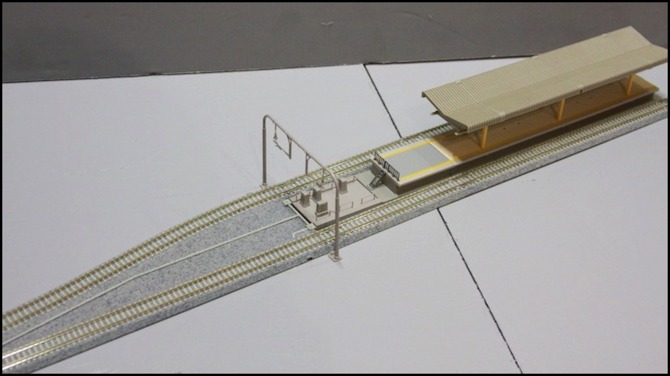
Passenger trains are boarded from areas alongside the track called “platforms”. As the name implies, these are often elevated structures at the height of the interior of the passenger car. Although “ground level” platforms, usually roughly level with the top of the rail, are fairly common on light-rail systems and North American commuter and rural stations, in Japan the “high level” platforms at car-floor height are nearly universal.
Kato makes a number of high-level platform elements that go along with their Unitrack and various station models. These are broadly divided into side platforms, where the platform is beside one track, and island platforms, where the platform is sandwiched between two tracks. These are all based around the standard Unitrack length of 248mm (9 3/4 inches), although the ends come in varying length. And the width of 41mm is designed to allow the island platforms to work with either Kato’s #4 or #6 switches, which widen track out to a 66mm center-to-center spacing between main line and siding when used with the correct track. For a list of all of these platform elements, diagrams of the track configurations used with them, and photographs of the platform types, see my Passenger Platforms page.
When Kato introduced their double-track, the standard method for widening its 33mm center-to-center spacing out to 66mm was to use a pair of R481 curves back-to-back, forming an S-curve. This is a fairly harsh bit of track to navigate, although most of Kato’s trains are quite forgiving of sharp curves and handle it just fine.
The other problem that Kato has had for a long time is that their double-track represents a modern form of track using precast concrete ties, while their single track, switches, and other special track elements represent track with wooden ties. The two are sometimes intermingled. In particular, use of wooden ties under switches is fairly common, even on lines that otherwise use concrete ties. But this meant that it was hard to replicate a modern station on a double-track line, since you had to use wooden ties in the stations and in other places special trackwork was needed.
Kato has finally addressed this, at least partially, with the introduction of their V15 Double-Track Set for Station (20-874), shown above, which provides a pair of 310mm long end pieces with concrete-tie track that widen out from 33mm to 66mm, as well as both 124mm and 248mm lengths of concrete-tie single track. The widening pieces are available separately (20-051 with the curve to the left and 20-052 with the curve to the right) and a four-pack of S248PC straight tracks is available (20-875). Oddly, the S124PC track is not presently sold separately. This set and its components just became available in Japan in March of 2011, but it is likely to find its way to U.S. and European stores fairly quickly. The packaging is already marked for both Kato and Kato U.S.A, and labelled in English. The “PC” suffix is used to differentiate the precast-concrete tie track from other kinds of track.
Note: Kato’s concrete-tie track uses a tie-to-tie spacing of roughly 4mm, or about 25 inches in 1:160 scale. On North American systems concrete ties may be spaced 24” to 30” apart, and the wider spacing is likely often used for cost reasons, so North American modelers may find the spacing unrealistic, although it is not entirely unprototypical.
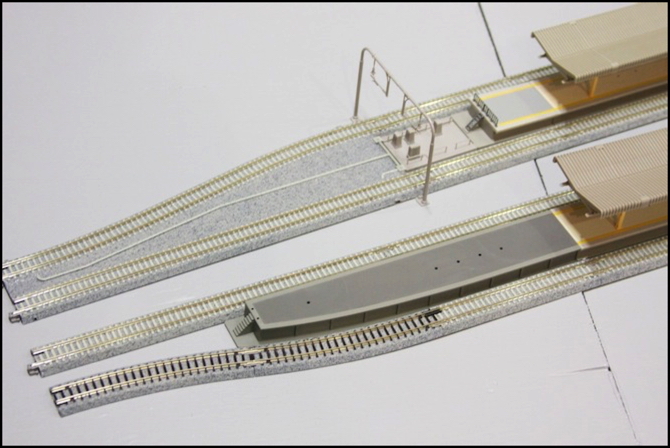
V15 WA310PC-L compared with R481 curves
Aside from allowing the construction of island-platform stations that use only concrete-tie track, the new end pieces provide a longer and gentler curve, more visually appealing with longer passenger cars, and probably more reliable for them as well. The downside is that about 200mm of platform length is lost at each end of the station. Still, the improvement in track curvature and appearance is well worth that cost. I’ve purchased a couple of sets, as well as a large quantity of the single-track, and am using it on the visible portions of my Subway and Express/Shinkansen lines. The Commuter line will remain with wooden ties, except where it is double-tracked, due to the large amount of single-track curves, switches and other special track elements used.

Subway station with concrete-tie track and tiled-floor platforms (the wall ads are photoshopped test images)
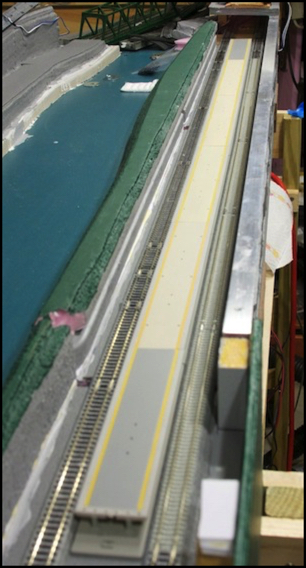
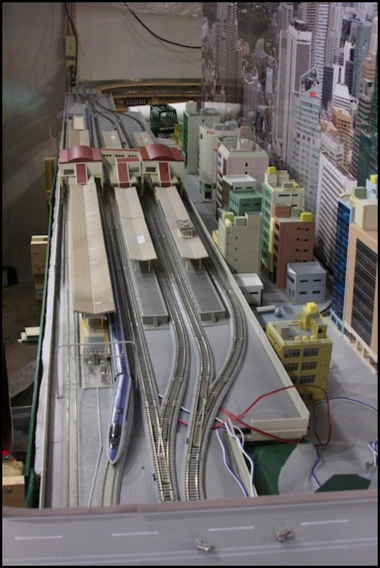
Subway station platform (under construction) Urban Station, with new curve on Shinkansen line
As you can see from the photo on the right, my 16-car Series 500 sticks out beyond the end of the platform at both ends (it’s a little hard to see the far end, but there’s a photo of the other end in the Station photo album). With the loss of 400mm of platform, my not-quite-long-enough platform is now sized for about 13 cars. I can extend it at the far end at the cost of re-arranging some trackwork, and I expect I’ll ultimately do that.
The new track looks very good with a long-car train such as a Shinkansen, as you can see in the photos above and below. It’s definitely a worthwhile addition to the layout.
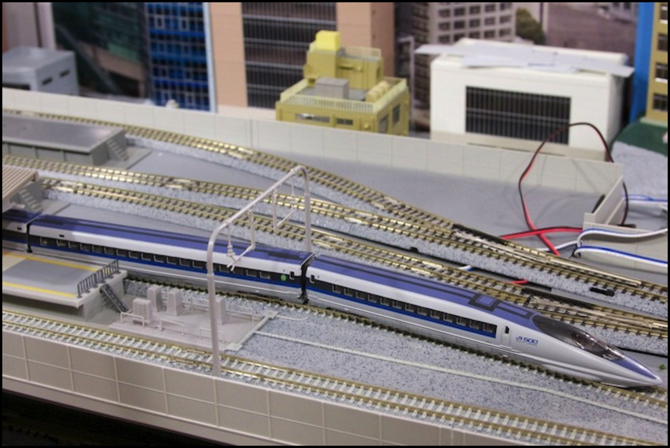
Series 500 negotiating the curve
The other thing you can see in these photos is the use of Kato’s new tiled-surface platform (23-107 to 23-109 structures) for the subway and the Shinkansen platform (I’m using the older asphalt-surface platforms, 23-100 to 23-106, for the two commuter line platforms in the right photo). I liked this in the urban station, as it helped the Shinkansen line stand out as different from the other line, and the addition of concrete-tie track now makes the difference even more pronounced. In the subway, the tiled surface just looked more correct for an indoor station.
The Urban Station still has quite a bit of work to be done, as you can see from the wires visible in these photos, and some problems with the platforms (I ran out of tile-surface platforms, and need to order more). But I think I’m going to finish up the work on the Riverside Station scene and enjoy running trains for a while, before I take the layout apart yet again to work on the viaduct station and surrounding streets.
Other website changes:
- Added photos to the Station photo album and diagrams to the Diagrams album.
- Added/update photos on the Urban Station Scene and Subway Scene pages.
- Added a page about advertising signs.
- Updated the LED Strip Lighting page with some comments about the color temperature of my “white” LEDs.




